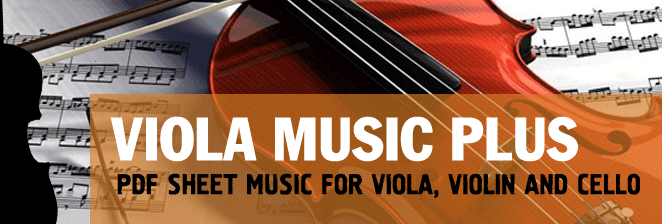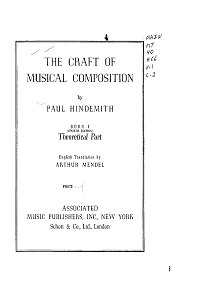|
|
 |
|
| |
| |
|
Hindemith Paul - The Craft of Musical Composition |
Hindemith Paul - The Craft of Musical Composition
Hindemith Paul - The Craft of Musical Composition. You can download the PDF sheet music Hindemith Paul - The Craft of Musical Composition on this page. To the composer, as well as the teacher, the book offers new perspectives on his materials, and makes clear that for a well- intentioned but arbitrary arrangement of sounds he must substitute an order which only to the uninitiated will seem a restriction of the creative process. In reality, wisely and sensibly directed work will result in greater variety than a profusion of over-seasoned or over- sweet progressions, the formula for which is soon transparent and thus available even to those who have no inner musical vocation.
The reader who lightly turns these pages in the hope of a stimulating general discussion will not be well rewarded. He will find the subject matter remote and dry, the more so as he is used to meeting the materials of music in living and flowering form, rather than on the dissecting table. Moreover, he finds more pleasure in the actual sound of music than in reading about it, and thus he may well leave the present accumulation of descriptions of abstract tone-successions, practical rules, and musical examples to those who can feel the pulse of music beneath the monotonous consideration of its materials.
The teacher must not base his instruction simply on the rules of textbooks. He must continually refresh and complete his knowledge from the practice of singing and playing. What he teaches must have been developed out of his own exercises in writing. For it is his task not only to teach the pupil a correct technique, but also to help him obtain a comprehensive musical education, seeing to it that his work in the practical fields is supplemented by an intelligent understanding of the theoretical side. It is up to him to pass on the most personal and most painfully arrived at secrets of the great composers, so that he may call forth in the student at least a small reflection of their light. At the same time, he must exercise a guiding and calming influence on the young musician who is in the throes of experiment; he must steer him between the Scylla of blind worship of the past and the Charybdis of idolatry of the present. Anyone who follows this profession for the sole purpose of earning his living is just as unworthy of it as is the (fortunately not too common) composer who submits unwillingly to what he considers the slavery of teaching, and poisons the student with his inevitable musical bad temoer.
Those industrious ones, too, who think that by memorizing and working hard at rules and precepts they will come by a recipe for producing convincing music had better give up the search. Finally, this book would represent a disappointment to the beginner who expected to find in it a reliable guide for self-instruction. It presupposes a considerable body of knowledge, and will therefore be valuable only to those who are already somewhat familiar with the technique of composition.
To download PDF, click the "Download PDF" button below the appropriate sheet music image.
To view the first page of Hindemith Paul - The Craft of Musical Composition click the music sheet image. |
PDF format
|
|
|
|
Book: 399 pages. 76099 K
|
|
 |
|
|
|
| Download PDF (14.99
€) |
|
|
In the present Theoretical Part of this work, the underlying principles of the new theory are first established and then developed. I have limited myself to what is really new, and to that older material to which I give a new interpretation. Such elements of older theories as have remained intact throughout all periods and styles, because they are independent of period and style, I have left untouched, except where it has been more convenient to rename or reclassify them. Nothing is said here about those things which remain unchanged, or about the actual writing of music, with its rules for voice-leading, spacing, and so on. Book II, devoted to actual writing in two parts, contains all this material, both old and new, presented in pedagogic order.
The reader who thinks that the views here expressed amount to a deification of materials, an undue exaggeration of the importance of mere craft, should remember that there was once a time when he had to absorb the rules of harmony, which, despite the limitations of the chordal material dealt with, were numerous enough. There is no denying the fact that to learn a new system takes time and trouble. But if one gains both a wider outlook and a more complete mastery, it is worth it. Technical skill can never be great enough. No one is too able or too accomplished to learn more than he knows. Technique must be learned as a child learns to move his limbs: what was difficult at first must become easy; it must be at one's instantaneous disposal; it must function so perfectly that its action is no longer noticed; it must sink to the level of subconscious activity.
Although the creative process in its highest stages may always remain hidden from human comprehension, as may the mysterious source of artistic work in general, yet the dividing point between conscious and unconscious work can be raised to an extraordinary degree. If this were not true, everyone in whom this point lies at a very low level could assert that he is creating the greatest works of art. There would be no difference between Beethoven and any other composer, who had with difficulty achieved a mere quarter, say, of the height of artistic achievement that men may attain, and knew nothing of the other three quarters that still lay above him. Such a little man would not care to speak of technical matters, but would instead refer to his impulse, his feeling, his heart, which had prescribed the way for him.
In this attitude toward the technical side of composition I am in agreement with views which were held long before the classic masters. We find such views in early antiquity, and far-sighted composers of the Middle Ages and of modern times hold firmly to them and pass them on. What did tonal materials mean to the ancients? Intervals spoke to them of the first days of the creation of the world: mysterious as Number, of the same stuff as the basic concepts of time and space, the very dimensions of the audible as of the visible world, building stones of the universe, which, in their minds, was constructed in the same proportions as the overtone series, so that measure, music, and the cosmos inseparably merged. And the art of composition itself? To musicians it was a means of praising God, and of enabling the community of listeners to take part in that praise. That the work has been created to the glory of the Highest Being, of whose support it is thus assured, we can feel in the music of many composers—above all in that of Bach, whose "Jesu iuva" in his scores was for hini no empty formula.
We cannot conjure up past times, although every man must come to some agreement with himself about the bases of his work. But that our consideration of tonal materials and its application by all who may concern themselves with it may catch a kindling spark from the spirit of the old masters is the hope from which this work springs. |
|
|
|
|
| |
|
|
| |
|
|
|
|